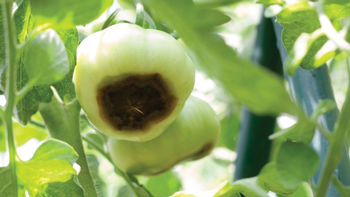Blossom End Rot
-
-
Environmental
-
-
Blossom end rot results from a low level of calcium in the fruit and water balance in the plant. It is aggravated by high soil salt content or low soil moisture and is more common on sandier soils.
 UC Marin Master Gardeners
UC Marin Master Gardeners -
Blossom end rot affects tomatoes, peppers, and cucurbits. Plants with blossom end rot show small, light brown spots at the blossom end of immature fruit. The affected area gradually expands into a sunken, leathery, brown or black lesion as the fruit ripens. Hard, brown areas may develop inside the fruit, either with or without external symptoms.
-
At the blossom end of immature fruit.
-
During the growing season, as the fruit is developing.
-
The conditions that cause blossom end rot are closely linked to inconsistent soil moisture throughout the growing season. Since calcium is only moved into the plant with an ample moisture supply, when drought (or any significant reduction of water) occurs the fruit continues to develop but will be affected by a calcium deficiency.
To reduce blossom end rot, monitor soil moisture to make sure that the root zone neither dries out nor remains saturated. Follow recommended rates for fertilizers. Some varieties are more affected than others.
Grow tomatoes in well-drained soil high in organic matter with a soil pH between 6.5 and 7.5.
Mulching tomatoes helps to conserve moisture in the soil.
-
This is primarily an overwatering or inconsistent watering issue during fruit development phase affecting how the fruit uptakes calcium.
Garden soils may have low levels of calcium. This can be determined by soil testing and can be corrected by adding lime as recommended on the soil test report. Do not add lime without having your soil tested first.
Infected fruit should be removed when first noticed. This rot does not spread from plant to plant or from fruit to fruit, so even if it occurs on your earliest tomatoes, it may not affect later tomatoes on the same plant. Fungicides and insecticides are useless as control measures for this disorder.

